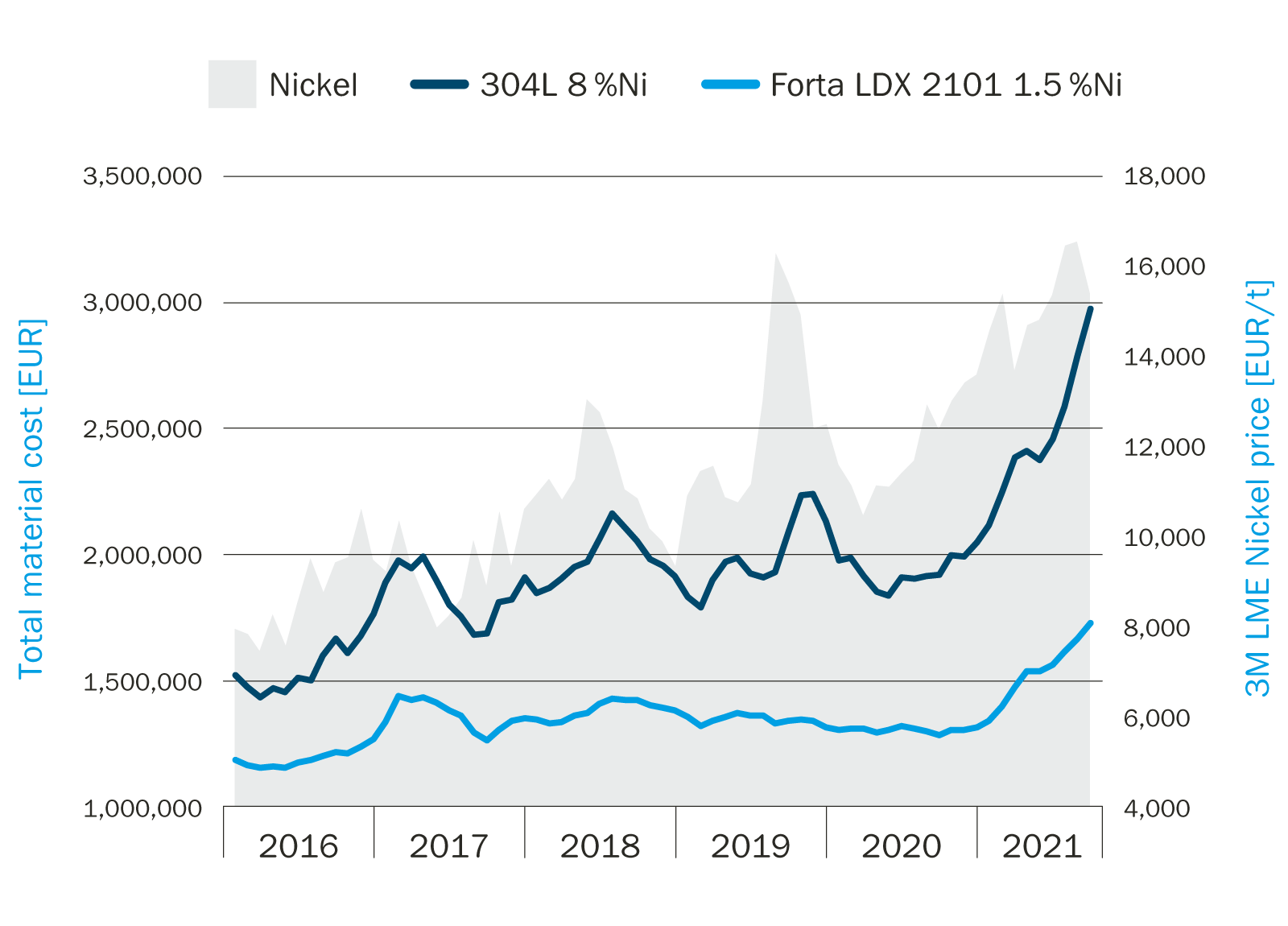 Image: Agroetanol AB plant
Image: Agroetanol AB plantRecent trends in the metal market have emphasized the cost stability of Forta LDX 2101, a lean duplex grade of stainless steel with low amounts of alloying elements such as nickel and molybdenum that are well known for their volatile pricing.
Price stability is one of several factors to consider when choosing a construction material for process equipment in pulp and paper mills. The grade of Forta LDX 2101 (EN 1.4162 / UNS S32101) also provides the properties and track record of experience in the industry.
Corrosion resistance for long life
The performance of lean duplex Forta LDX 2101 has been utilized by the pulp and paper industry since we launched it in 2004. Experience has shown that it has exceptional performance in, for example, alkaline environments towards typical deterioration mechanisms i.e. uniform corrosion and stress corrosion cracking. This is achieved by the combination of chemistry and microstructure.
Both the experience and laboratory testing have shown that high chromium content, and often surprisingly, low molybdenum content are beneficial for the corrosion resistance in the alkaline solutions that are typical in the industry. In addition, the grade’s dual-phase austenitic-ferritic microstructure ensures strong resistance against stress corrosion cracking, which is often problematic for austenitic stainless steels.
Forta LDX 2101 is also well suited for hot water applications in the pulp and paper industry, provided that the chlorides are under control. Similar to its performance in alkaline environments, lean duplex has strong resistance against stress corrosion cracking in hot water applications.
To help design engineers, we have used data from laboratory testing and experience to create material selection diagrams for typical environments in pulp and paper processes. Our technical experts are always available to offer advice on overcoming challenges in material selection.
High strength is also often preferred feature in the pulp and paper construction as it enables lighter structures and less material to be utilized. Forta LDX 2101 has exceptionally high mechanical strength as a result of dual-phase microstructure and by nitrogen alloying.
Concept of lean duplex
The lean duplex grade of stainless steel can be an attractive alternative grade for pulp and paper processes compared with the standard austenitic grade EN 1.4307 / ASTM 304L or in some cases for EN 1.4404 /316L. The chemical composition, PRE-number and strength values of these steels are shown in the Table 1: The chemical composition comparison of Lean Duplex with typical austenitic grades. This clearly shows that lean duplex has low nickel content compared to austenitic variants – which is the most volatile element in stainless steel pricing. In addition to this it has low content of expensive molybdenum as its corrosion resistance is achieved through high chromium content and nitrogen alloying.
Table 1. The chemical composition comparison of Lean Duplex with typical austenitic grades.
| OUTOKUMPU NAME | TYPE | EN | ASTM / ASME | CR | Ni | MO | N | PRE1) | RP0.2 | RM | A5 | |
|---|---|---|---|---|---|---|---|---|---|---|---|---|
| TYPE | UNS | [%] | [%] |
[%] | [%] | MPA 2) | MPA 2) | % 2) | ||||
| Core 304L/4307 | Austenitic | 1.4307 | 304L | S30403 | 18.1 | 8.3 | – | – | 18 | 200 | 500 | 45 |
| Supra 316L/4404 | Austenitic | 1.4404 | 316L | S31603 | 17.2 | 10.1 | 2.1 | – | 24 | 220 | 520 | 45 |
| Forta LDX 2101 | Lean Duplex | 1.4162 | – | S32101 | 21.5 | 1.5 | 0.3 | 0.22 | 26 | 450 | 650 | 30 |
| 1) PRE = %Cr + 3.3x%Mo + 16x%N, 2) EN 10028-7:2016 Hot rolled plate | ||||||||||||
Most importantly, the lean concept provides predictability in material cost that is crucial for large investment projects. The cost of Forta LDX 2101 does not react to changing raw material prices and the steel markets like standard austenitic grades. Finally, thanks to its wide global use, the steel is well available from 0.4 mm cold rolled sheets up to 100 mm thick quarto plates.
Cost comparison with a Kraft pulp digester
The advantages of high-strength duplex stainless steel over standard austenitic can be expressed through the design case of kraft pulp digester. Because the lean duplex alloy can withstand significantly higher stress, its wall thickness can be a little over half of that required for the austenitic grade, saving hundreds of tonnes in material.

Table 2. Using a high-strength alloy reduces the thickness of a pressure vessel’s walls.
| GRADE | Design stress EN 13445 |
THICKNESS MIN – MAX |
TOTAL SHELL WEIGHT |
WEIGHT SAVINGS |
|---|---|---|---|---|
| 304L/4307 | 123 MPa | 24 – 88 mm | 892 t | Ref. |
| Forta LDX 2101 | 225 MPa | 14 – 48 mm | 516 t | 42% |
The graph below shows how the nickel price and steel markets have influenced the purchase price of the material required when building a typical kraft digester between 304L and Forta LDX 2101. It includes the weight saving for Forta LDX 2101 and it is easy to see the price stability and predictability of the lean duplex alloy.
It’s also worth factoring in potential savings during fabrication and construction. Because a tank made from the lean duplex alloy will be lighter in weight, it will require be less costly to construct, due to a need for less welding and handling.

Performance and price
It’s always important to choose a material that provides the right corrosion resistance and mechanical properties for the job. This ensures reliability over a long life. However, smart engineers should also keep an eye on alloy pricing to ensure cost-effectiveness for their projects.
For more information, contact:
Edwin Maalderink, Lead Technical Manager – Heavy Industry,
edwin.maalderink@outokumpu.com
Mikko Palosaari, Project Sales Manager,
mikko.palosaari@outokumpu.com
